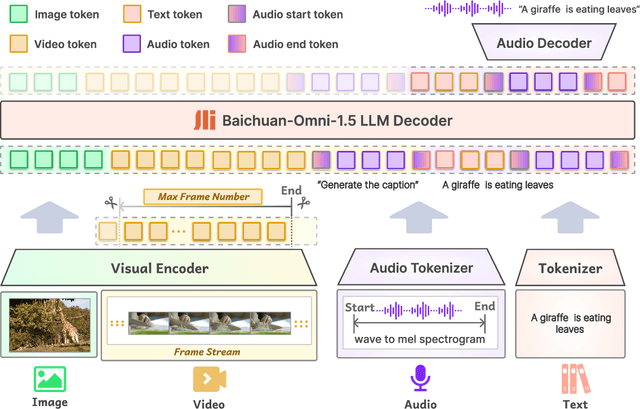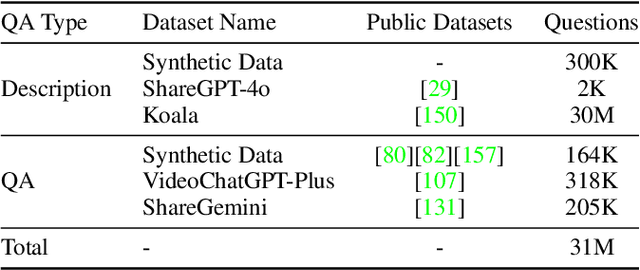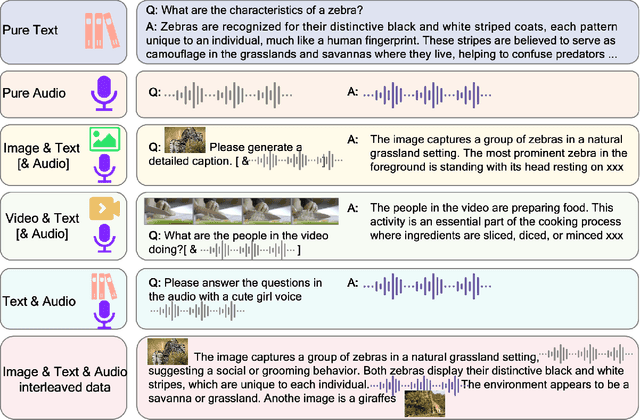Song Chen
Baichuan-Omni-1.5 Technical Report
Jan 26, 2025



Abstract:We introduce Baichuan-Omni-1.5, an omni-modal model that not only has omni-modal understanding capabilities but also provides end-to-end audio generation capabilities. To achieve fluent and high-quality interaction across modalities without compromising the capabilities of any modality, we prioritized optimizing three key aspects. First, we establish a comprehensive data cleaning and synthesis pipeline for multimodal data, obtaining about 500B high-quality data (text, audio, and vision). Second, an audio-tokenizer (Baichuan-Audio-Tokenizer) has been designed to capture both semantic and acoustic information from audio, enabling seamless integration and enhanced compatibility with MLLM. Lastly, we designed a multi-stage training strategy that progressively integrates multimodal alignment and multitask fine-tuning, ensuring effective synergy across all modalities. Baichuan-Omni-1.5 leads contemporary models (including GPT4o-mini and MiniCPM-o 2.6) in terms of comprehensive omni-modal capabilities. Notably, it achieves results comparable to leading models such as Qwen2-VL-72B across various multimodal medical benchmarks.
Ocean-OCR: Towards General OCR Application via a Vision-Language Model
Jan 26, 2025



Abstract:Multimodal large language models (MLLMs) have shown impressive capabilities across various domains, excelling in processing and understanding information from multiple modalities. Despite the rapid progress made previously, insufficient OCR ability hinders MLLMs from excelling in text-related tasks. In this paper, we present \textbf{Ocean-OCR}, a 3B MLLM with state-of-the-art performance on various OCR scenarios and comparable understanding ability on general tasks. We employ Native Resolution ViT to enable variable resolution input and utilize a substantial collection of high-quality OCR datasets to enhance the model performance. We demonstrate the superiority of Ocean-OCR through comprehensive experiments on open-source OCR benchmarks and across various OCR scenarios. These scenarios encompass document understanding, scene text recognition, and handwritten recognition, highlighting the robust OCR capabilities of Ocean-OCR. Note that Ocean-OCR is the first MLLM to outperform professional OCR models such as TextIn and PaddleOCR.
Baichuan-Omni Technical Report
Oct 11, 2024



Abstract:The salient multimodal capabilities and interactive experience of GPT-4o highlight its critical role in practical applications, yet it lacks a high-performing open-source counterpart. In this paper, we introduce Baichuan-Omni, the first open-source 7B Multimodal Large Language Model (MLLM) adept at concurrently processing and analyzing modalities of image, video, audio, and text, while delivering an advanced multimodal interactive experience and strong performance. We propose an effective multimodal training schema starting with 7B model and proceeding through two stages of multimodal alignment and multitask fine-tuning across audio, image, video, and text modal. This approach equips the language model with the ability to handle visual and audio data effectively. Demonstrating strong performance across various omni-modal and multimodal benchmarks, we aim for this contribution to serve as a competitive baseline for the open-source community in advancing multimodal understanding and real-time interaction.
PiRD: Physics-informed Residual Diffusion for Flow Field Reconstruction
Apr 12, 2024



Abstract:The use of machine learning in fluid dynamics is becoming more common to expedite the computation when solving forward and inverse problems of partial differential equations. Yet, a notable challenge with existing convolutional neural network (CNN)-based methods for data fidelity enhancement is their reliance on specific low-fidelity data patterns and distributions during the training phase. In addition, the CNN-based method essentially treats the flow reconstruction task as a computer vision task that prioritizes the element-wise precision which lacks a physical and mathematical explanation. This dependence can dramatically affect the models' effectiveness in real-world scenarios, especially when the low-fidelity input deviates from the training data or contains noise not accounted for during training. The introduction of diffusion models in this context shows promise for improving performance and generalizability. Unlike direct mapping from a specific low-fidelity to a high-fidelity distribution, diffusion models learn to transition from any low-fidelity distribution towards a high-fidelity one. Our proposed model - Physics-informed Residual Diffusion, demonstrates the capability to elevate the quality of data from both standard low-fidelity inputs, to low-fidelity inputs with injected Gaussian noise, and randomly collected samples. By integrating physics-based insights into the objective function, it further refines the accuracy and the fidelity of the inferred high-quality data. Experimental results have shown that our approach can effectively reconstruct high-quality outcomes for two-dimensional turbulent flows from a range of low-fidelity input conditions without requiring retraining.
Graph Attention-Based Symmetry Constraint Extraction for Analog Circuits
Dec 22, 2023



Abstract:In recent years, analog circuits have received extensive attention and are widely used in many emerging applications. The high demand for analog circuits necessitates shorter circuit design cycles. To achieve the desired performance and specifications, various geometrical symmetry constraints must be carefully considered during the analog layout process. However, the manual labeling of these constraints by experienced analog engineers is a laborious and time-consuming process. To handle the costly runtime issue, we propose a graph-based learning framework to automatically extract symmetric constraints in analog circuit layout. The proposed framework leverages the connection characteristics of circuits and the devices'information to learn the general rules of symmetric constraints, which effectively facilitates the extraction of device-level constraints on circuit netlists. The experimental results demonstrate that compared to state-of-the-art symmetric constraint detection approaches, our framework achieves higher accuracy and lower false positive rate.
AiDAC: A Low-Cost In-Memory Computing Architecture with All-Analog Multi-Bit Compute and Interconnect
Dec 21, 2023



Abstract:Analog in-memory computing (AiMC) is an emerging technology that shows fantastic performance superiority for neural network acceleration. However, as the computational bit-width and scale increase, high-precision data conversion and long-distance data routing will result in unacceptable energy and latency overheads in the AiMC system. In this work, we focus on the potential of in-charge computing and in-time interconnection and show an innovative AiMC architecture, named AiDAC, with three key contributions: (1) AiDAC enhances multibit computing efficiency and reduces data conversion times by grouping capacitors technology; (2) AiDAC first adopts row drivers and column time accumulators to achieve large-scale AiMC arrays integration while minimizing the energy cost of data movements. (3) AiDAC is the first work to support large-scale all-analog multibit vector-matrix multiplication (VMM) operations. The evaluation shows that AiDAC maintains high-precision calculation (less than 0.79% total computing error) while also possessing excellent performance features, such as high parallelism (up to 26.2TOPS), low latency (<20ns/VMM), and high energy efficiency (123.8TOPS/W), for 8bits VMM with 1024 input channels.
NicePIM: Design Space Exploration for Processing-In-Memory DNN Accelerators with 3D-Stacked-DRAM
May 30, 2023



Abstract:With the widespread use of deep neural networks(DNNs) in intelligent systems, DNN accelerators with high performance and energy efficiency are greatly demanded. As one of the feasible processing-in-memory(PIM) architectures, 3D-stacked-DRAM-based PIM(DRAM-PIM) architecture enables large-capacity memory and low-cost memory access, which is a promising solution for DNN accelerators with better performance and energy efficiency. However, the low-cost characteristics of stacked DRAM and the distributed manner of memory access and data storing require us to rebalance the hardware design and DNN mapping. In this paper, we propose NicePIM to efficiently explore the design space of hardware architecture and DNN mapping of DRAM-PIM accelerators, which consists of three key components: PIM-Tuner, PIM-Mapper and Data-Scheduler. PIM-Tuner optimizes the hardware configurations leveraging a DNN model for classifying area-compliant architectures and a deep kernel learning model for identifying better hardware parameters. PIM-Mapper explores a variety of DNN mapping configurations, including parallelism between branches of DNN, DNN layer partitioning, DRAM capacity allocation and data layout pattern in DRAM to generate high-hardware-utilization DNN mapping schemes for various hardware configurations. The Data-Scheduler employs an integer-linear-programming-based data scheduling algorithm to alleviate the inter-PIM-node communication overhead of data-sharing brought by DNN layer partitioning. Experimental results demonstrate that NicePIM can optimize hardware configurations for DRAM-PIM systems effectively and can generate high-quality DNN mapping schemes with latency and energy cost reduced by 37% and 28% on average respectively compared to the baseline method.
Remote Sensing Image Change Detection Towards Continuous Bitemporal Resolution Differences
May 24, 2023



Abstract:Most contemporary supervised Remote Sensing (RS) image Change Detection (CD) approaches are customized for equal-resolution bitemporal images. Real-world applications raise the need for cross-resolution change detection, aka, CD based on bitemporal images with different spatial resolutions. Current cross-resolution methods that are trained with samples of a fixed resolution difference (resolution ratio between the high-resolution (HR) image and the low-resolution (LR) one) may fit a certain ratio but lack adaptation to other resolution differences. Toward continuous cross-resolution CD, we propose scale-invariant learning to enforce the model consistently predicting HR results given synthesized samples of varying bitemporal resolution differences. Concretely, we synthesize blurred versions of the HR image by random downsampled reconstructions to reduce the gap between HR and LR images. We introduce coordinate-based representations to decode per-pixel predictions by feeding the coordinate query and corresponding multi-level embedding features into an MLP that implicitly learns the shape of land cover changes, therefore benefiting recognizing blurred objects in the LR image. Moreover, considering that spatial resolution mainly affects the local textures, we apply local-window self-attention to align bitemporal features during the early stages of the encoder. Extensive experiments on two synthesized and one real-world different-resolution CD datasets verify the effectiveness of the proposed method. Our method significantly outperforms several vanilla CD methods and two cross-resolution CD methods on the three datasets both in in-distribution and out-of-distribution settings. The empirical results suggest that our method could yield relatively consistent HR change predictions regardless of varying resolution difference ratios. Our code will be public.
Accelerated Distributed Aggregative Optimization
Apr 17, 2023Abstract:In this paper, we investigate a distributed aggregative optimization problem in a network, where each agent has its own local cost function which depends not only on the local state variable but also on an aggregated function of state variables from all agents. To accelerate the optimization process, we combine heavy ball and Nesterov's accelerated methods with distributed aggregative gradient tracking, and propose two novel algorithms named DAGT-HB and DAGT-NES for solving the distributed aggregative optimization problem. We analyse that the DAGT-HB and DAGT-NES algorithms can converge to an optimal solution at a global $\mathbf{R}-$linear convergence rate when the objective function is smooth and strongly convex, and when the parameters (e.g., step size and momentum coefficients) are selected within certain ranges. A numerical experiment on the optimal placement problem is given to verify the effectiveness and superiority of our proposed algorithms.
Language-aware Multiple Datasets Detection Pretraining for DETRs
Apr 07, 2023



Abstract:Pretraining on large-scale datasets can boost the performance of object detectors while the annotated datasets for object detection are hard to scale up due to the high labor cost. What we possess are numerous isolated filed-specific datasets, thus, it is appealing to jointly pretrain models across aggregation of datasets to enhance data volume and diversity. In this paper, we propose a strong framework for utilizing Multiple datasets to pretrain DETR-like detectors, termed METR, without the need for manual label spaces integration. It converts the typical multi-classification in object detection into binary classification by introducing a pre-trained language model. Specifically, we design a category extraction module for extracting potential categories involved in an image and assign these categories into different queries by language embeddings. Each query is only responsible for predicting a class-specific object. Besides, to adapt our novel detection paradigm, we propose a group bipartite matching strategy that limits the ground truths to match queries assigned to the same category. Extensive experiments demonstrate that METR achieves extraordinary results on either multi-task joint training or the pretrain & finetune paradigm. Notably, our pre-trained models have high flexible transferability and increase the performance upon various DETR-like detectors on COCO val2017 benchmark. Codes will be available after this paper is published.
 Add to Chrome
Add to Chrome Add to Firefox
Add to Firefox Add to Edge
Add to Edge